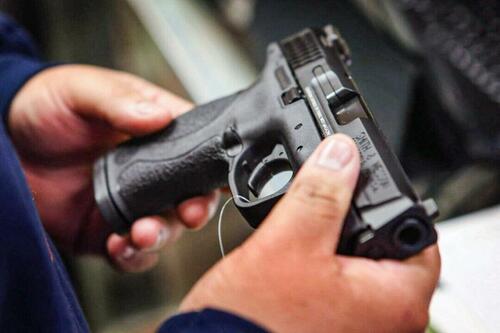In what must be the first time California's 9th circuit has ruled in favor of the 2nd Amendment, non-violent convicted felons can now own guns.
The decision stems from a 2020 case, in which California resident Steven Duarte was arrested after tossing a handgun out of a moving car during a traffic stop. He was indicted by a federal grand jury for possessing said firearm while being previously convicted of "a crime punishable by imprisonment for a term exceeding one year" in violation of the federal “felon-in-possession” law.

Duarte had five prior non-violent criminal convictions in California; vandalism, felon in possession of a firearm, drug possession, and two convictions for fleeing a police officer - each of which is punishable by one year or more in prison. After pleading not guilty, Duarte's case proceeded to trial, where he was found guilty and sentenced to 51 months in prison.
Not so fast!
As the Epoch Times notes further, in a 2-1 decision handed down on May 9, the Ninth Circuit Court of Appeals ruled that Mr. Duarte’s conviction violated the Second Amendment as applied to him.
Specifically, the court’s majority found that the federal government failed to prove that its felon-in-possession law supports disarming convicted felons for life under a two-step framework established by the U.S. Supreme Court in the 2022 “New York State Rifle & Pistol Association Inc. v. Bruen” case.
The two-step process, put forth by U.S. Supreme Court Justice Clarence Thomas, first requires the court to determine whether the Second Amendment’s “plain text” covers an individual’s conduct. If so, then that conduct is presumptively protected, and the government must prove that its law is “consistent with this Nation’s historical tradition of firearm regulation.”
“Because Duarte is an American citizen, he is part of the people whom the Second Amendment protects,” Senior Circuit Judge Carlos Bea wrote for the majority.
“The Government argues only that ’the people‘ in the Second Amendment excludes felons like Duarte because they are not members of the ’virtuous’ citizenry,” he wrote. “We do not share that view.”
The burden then fell back to the federal government to show that its gun possession policy aligns with the “historical tradition” of the United States.
However, during the Early Republic era, Mr. Duarte’s past convictions either would have been considered misdemeanors, didn’t exist as a crime, or may have had predecessors for which the government failed to provide evidence of their existence, Judge Bea noted.
“Based on this record, we cannot say that Duarte’s predicate offenses were, by Founding-era standards, of a nature serious enough to justify permanently depriving him of his fundamental Second Amendment rights,” the majority opinion read.
“The Second Amendment’s plain text and historically understood meaning therefore presumptively graduate his individual right to possess a firearm for self-defense.”
Judge Bea, a George W. Bush appointee, was joined by Circuit Judge Lawrence VanDyke, a Donald Trump appointee. The majority opinion overturned a 2010 Ninth Circuit precedent, “U.S. v. Vongxay”, which upheld the federal prohibition on possession of firearms by felons.
Circuit Judge Milan Smith, a George W. Bush appointee who penned the Vongxay opinion, dissented and urged the appeals court to order a new hearing of Mr. Duarte’s case before a full, 11-judge panel.
He argued that Buren does not override Vongxay, at least not before the U.S. Supreme Court further clarifies the constitutionality of the federal felon-in-possession law.
“One day—likely sooner, rather than later—the Supreme Court will address the constitutionality of [the federal felon firearm ban] or otherwise provide clearer guidance on whether felons are protected by the Second Amendment,” Judge Smith wrote in his dissenting opinion.
“But it is not our role as circuit judges to anticipate how the Supreme Court will decide future cases.”
The Ninth Circuit’s vacation of Mr. Duarte’s conviction added to the post-Bruen “Circuit Split” over the scope of the Second Amendment.
The Ninth Circuit joins, at least for now, the Third Circuit to rule in favor of Americans permanently stripped of Second Amendment rights because of past non-violent offenses, while the Tenth Circuit has reaffirmed its precedent upholding the restriction on those individuals.
In a 2-1 ruling last October, the Tenth Circuit observed that the Bruen Court “didn’t appear to question the constitutionality of longstanding prohibitions on possession of firearms by convicted felons.”
Instead, it argued, “Bruen apparently approved the constitutionality of regulations requiring criminal background checks ... to ensure that the applicant is a ‘law-abiding, responsible citizen.’”